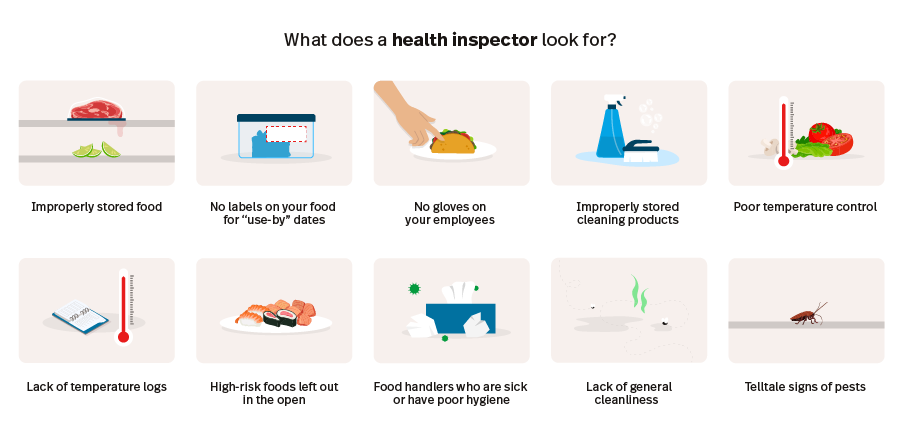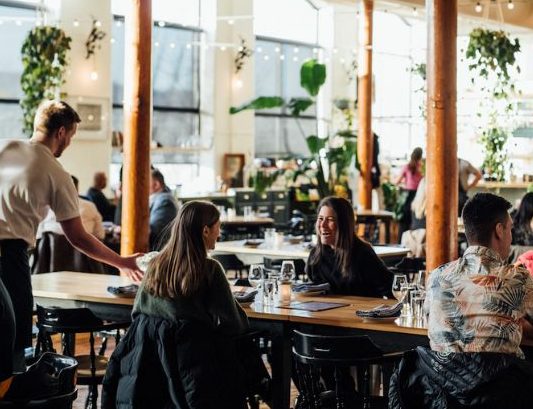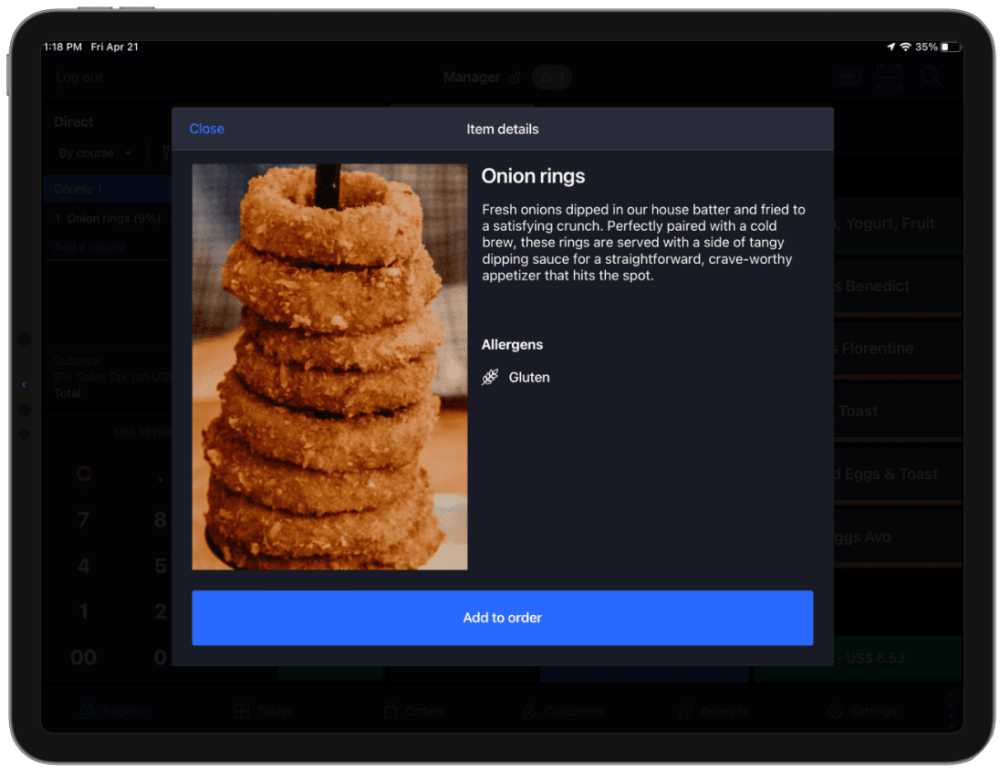
Restaurant health inspections exist to protect the public from food safety hazards that can occur from improper food handling practices. To pass one, it’s critical that you store, thaw and cook food in adherence with food safety regulations and that your kitchen, freezers and storage areas are kept clean.
Failure to do so can be extremely costly. Violations found by a health inspector can lead to fines and even being forced to close your doors until conditions and food safety are improved—not to mention customers losing trust in your establishment.
Read on to learn how to get an A+ on your next restaurant health inspection.
- What is a restaurant health inspection?
- Why is it crucial to pass your inspection?
- How often do health inspections happen?
- What does a health inspector look for?
- What to expect if you receive a violation
- Food safety and allergies
- Food safety rules and regulations
- 6 tips for acing your restaurant health inspection
- Restaurant health inspection checklist
What is a restaurant health inspection?
A restaurant health inspection is an examination of your restaurant, staff and food products for potentially hazardous or unsafe materials. This can be during storage, production, processing or even packaging.
A health inspector will pay meticulous attention to how you store, thaw and cook food. He or she will also note the cleanliness of your kitchen, storage areas and freezers.
Why is it crucial to pass a restaurant health inspection?
Few things are worse for your restaurant’s sales and its reputation than a failed health inspection. If customers see a “fail” or “closed” sign posted on your door, view worrying details of your results online, or find you on a name-and-shame list compiled by your local media, there’s a strong chance you’re never getting another chance to win their business.
In this digital age, secrecy does not exist—many municipalities have made it extremely easy to view, in detail, the results of a restaurant health inspection in a matter of seconds.
Take Toronto Public Health’s DineSafe program, for example. They post restaurant health inspection results publicly online where consumers can search by restaurant name, address and/or proximity to the consumer.
For example, this restaurant got a conditional pass. With just one click, its current and prospective customers can quickly uncover some pretty disturbing details. It’s hard to imagine their bottom line didn’t take a hit because of it.

Restaurant health inspection results posted on Toronto’s DineSafe |
In New York, you can find health inspection results for New York City’s 27,000 restaurants on ABCEats, the City’s restaurant inspection lookup tool.
Would you still want to eat at this restaurant after seeing these results?

Restaurant health inspection results posted on New York’s ABCEats |
The UK’s Food Standards Agency also provides a platform where users can choose a country, county, town, or borough within the UK and instantly search for a registered establishment to discover its food hygiene rating. The rating, which ranges from 0 to 5, is based on three criteria: hygienic food handling, cleanliness and condition of facilities and buildings, and food safety management.
When do restaurant health inspections occur?
Restaurant health inspections can happen between one and four times a year at random intervals; but, on average, restaurants can expect to greet an inspector once every six months. Health inspectors are also obligated to pay you a visit if a customer reports a concern or lodges a complaint with your local, regional or provincial health authority.
What does a health inspector look for?
Health inspectors have one goal: to protect the public from health risks—such as food poisoning, allergens or foreign objects—that can be caused by food contamination and/or unsanitary conditions.
During a restaurant health inspection, the inspector will be on the lookout for things like:
- Improperly stored food (e.g. storing raw ingredients under dripping meat)
- No labels on your food for “use-by” dates
- No gloves on your employees
- Improperly stored chemicals/cleaning products
- Poor temperature control
- Lack of temperature logs
- High-risk foods left out in the open
- Food handlers who are sick or have poor hygiene
- Lack of general cleanliness
- Telltale signs of pests
They’re also going to expect your managers and staff to be trained on—and adhere to—food safety best practices. They will observe your front and back of house employees as they work to ensure they demonstrate safe food handling procedures, and they may ask your managers or frontline staff questions to test their knowledge.

What happens if you receive a food safety violation?
If you receive a violation during your restaurant health inspection, the important thing is not to panic. Your immediate priority should be to find and implement a solution, fast.
For minor violations
If it’s a minor violation—which are infractions that present a minimal health risk—you’ll probably get the chance to correct the issue within a prescribed timeframe.
You may not even be financially penalized (depending on the gravity of the violation), but it will be recorded and you’ll be subject to a follow-up inspection, usually within 24-48 hours. If minor violations aren’t corrected before the follow-up inspection, you risk getting issued a fine—and it can be a pretty significant one.
Examples of minor infractions may include:
- Walls, floors or other non-food contact surfaces or equipment need cleaning or repair (e.g., cracked or missing floor tiles, cracked or peeling paint not directly over food preparation area)
- Inadequate ventilation or lighting
- Food handlers not wearing hair nets
If you get clocked for minor violations on your restaurant health inspection, make sure to follow up with your staff to correct any knowledge gaps these violations may reveal. Be sure to emphasize the importance of adhering to food safety procedures, and test your employees’ knowledge.
For major violations
If the violation is more serious and a potential health hazard, you may face a significant fine and be required to close the business until you fix the issue.
Examples of major food safety violations include (but are not limited to):
- Food contact surfaces or equipment require cleaning or repair
- Refrigeration and/or mechanical dishwashing equipment require repair
- Accurate indicating thermometers not provided
- Lack of hand wash basin with the necessary supplies
- Garbage not stored in a sanitary manner
- Improper cleaning and sanitizing of equipment and utensils
- Washroom cleanliness not maintained, supplies not provided
Continued failure to comply with food safety regulations puts your restaurant at risk of being closed permanently. Plus, as discussed above, food safety violations are posted publicly on your local health department’s website, which is a serious threat to your reputation.
Want to run your restaurant at full speed?
Learn more about Lightspeed's complete restaurant management system.

Food safety and food allergies
More than 2.4 million people in the UK are affected by diagnosed food allergies. Restaurants owe a duty of care to their customers to, at a minimum:
- be aware of common food allergies; and
- help their customers understand the ingredients in their products so the customer can make informed decisions.
If a restaurant breaches its duty of care and causes harm to a customer, it can be held legally liable for damages. A breach of care could look like:
- cross-contamination causing an accidental allergic reaction
- giving incorrect information when customers ask questions about allergens
- responding inappropriately when a person has an allergic reaction to food while dining in house
Restaurants and hospitality establishments in the UK are all held to a set of standards and regulations enforced by the Food Standards Agency (FSA), as well as local authorities.
While the core principles and much of the legislation regarding food hygiene and safety are the same across England, Scotland, and Wales, there are some differences in how these regulations are implemented and enforced due to the governance across the UK.
These regulations include, but are not limited to:
- Food Safety Act 1990 and the Food Hygiene (England) Regulations 2006: These legislations outline the responsibilities of food businesses to ensure that the food they sell is safe for consumption. It covers aspects such as food labelling, contamination prevention, and the enforcement of food safety standards.
- Food Hygiene Rating Scheme: As mentioned above, this scheme, run by the FSA, assesses the hygiene standards of food businesses and assigns them a rating from 0 to 5.
- Allergen Regulations: Food businesses are required to provide clear information about the presence of allergens in their food. This includes labelling allergenic ingredients on pre-packaged food and providing allergen information to customers for non-prepackaged food.
- Health and Safety Regulations: In addition to food safety regulations, restaurants in the UK must comply with health and safety regulations to ensure the safety of their staff and customers. This includes measures to prevent accidents, such as maintaining a safe environment and providing adequate training for staff.
Handling food allergies in a restaurant can be stressful or downright scary if you don’t have the necessary workflows or resources in place. But it really doesn’t have to be.
With something as simple as a mobile restaurant point of sale—invaluable for restaurants for a myriad of reasons—you can put allergen information in the hands of every front of house employee.
For example, in the backend of Lightspeed Restaurant, you can add labels to menu items containing common allergens.

When an employee taps and holds down on the item on the POS, they’ll be able to see instantly if the item contains a potentially harmful ingredient.

This simple solution can help drastically reduce the risk of misinforming a customer who asks about allergens. It can also help prevent service from going off the rails because a server has to hunt down inaccessible information.
Food safety rules and regulations
In the United States, while all food safety regulations are variations of the model proposed by the U.S. Food and Drug Administration (FDA), there is no national standard code. Each state makes its own decisions as to what goes into their codes. Find your state’s food code here. You’ll also want to consult your local health department to find out about any local/municipal food safety regulations.
It’s a similar situation in Canada, where provincial and territory-specific food safety regulations are based on the federal food safety laws established by Health Canada. Restaurants need to comply with all provincial food safety codes, as well as any additional regulations imposed by their municipal government.
6 tips for acing any restaurant health inspection
The best strategy for passing a restaurant health inspection is to act like every day is a health inspection day. Here are some food safety best practices to keep in mind:
1. Establish consistent cleaning schedules
It may seem like a no-brainer, but your restaurant should have established, consistent cleaning schedules for tasks that need to be completed daily, weekly, monthly, etc.
Make sure your employees understand what’s expected of them and hold people accountable when tasks crucial to health and hygiene are not completed. Something as simple as a checklist goes a long way to making sure important tasks get done consistently and on time.
And while opening and closing duties quickly become second nature for both front and back of house employees, tasks that need to get done on a weekly or monthly basis are easier to forget. Be sure to establish standard routines and schedules for weekly and monthly cleaning tasks as well.
2. Make sure every employee has their Food Handler’s Permit
A Food Handler’s Permit (also called a Food Handler Certificate) is issued to individuals who complete a government-recognized food safety course. These food safety courses teach employees about safe food storage, preparation and handling procedures. Many of these courses can be completed in less than 24 hours.
When your employees have formal food safety training, it goes a long way to ensuring that your restaurant will stay in compliance with food safety codes and pass any restaurant health inspection. Many states and provinces will require you to have a certain number of certified food handlers on shift at any given time.
Giving preference to job applicants who are already certified could help you meet that obligation more easily, or you could also send key members of staff to training (or just have them complete a course online).
3. Keep sick employees at home
For a long time, the restaurant industry operated with an “if you’re not dead, we expect you to come in” mentality. But that mentality was terrible, and likely responsible for up to 40% of restaurant food poisoning outbreaks.
Having to cover a shift last-minute or running a service short-staffed is not great, we know. But it’s a lot better than dragging your sick employees into work where they’re going to contaminate your food and potentially infect your customers and other staff members.
Plus, with employee management software, covering last-minute shifts can be a lot easier with features like group chat and push notifications.
4. Give your employees food safety training and resources
Food safety training is essential for all restaurant employees. Whether it’s an official food safety course or on-the-job training, all employees need to understand the risks, potential consequences, and what they need to do to prevent them.
Besides job-specific training, it’s a good idea to provide employees in the front and back of house with additional resources they can use to upgrade their skills and knowledge. That could look like:
- a section on food safety information and procedures in your Employee Handbook
- an easily-accessible physical binder or digital folder of reference material
- printed posters/infographics posted in the kitchen or break area (e.g. safe cooking temperature charts, etc.)
Remember that food safety training is an ongoing process. Be sure to correct any food handling mistakes you see happening on the spot, and demonstrate the proper technique employees should use instead.
5. Stay up-to-date with food safety regulations
Keeping up with food safety guidelines as they change can be a challenge for restaurant owners, especially as they expand and open more locations in other provinces, states and cities.
Janilyn Hutchings, Food Scientist at StateFoodSafety and certified professional in food safety, recommends directly contacting your local health department to stay on top of food safety guidelines.
“Food safety guidelines vary depending on the city, state or province where a restaurant is located. In general, it’s a good idea to periodically call the health department(s) you report to—say, once a year—to make sure you’re staying on top of those guidelines as they change.”
6. Conduct your own restaurant health inspections
Regular self-audits are an essential part of maintaining a high standard of food safety and preventing health code violations. Ideally, you’ll conduct a self-led restaurant health inspection on a monthly or quarterly basis—depending on the size and complexity of your restaurant. Be meticulous.
It’s a good idea to create and use a comprehensive checklist as a guide so you can ensure that no critical areas are overlooked during your self-audit. We’ve put together an example of a restaurant health inspection checklist below. Feel free to use this example as a starting point for your own inspection checklist.
Restaurant health inspection checklist
Food storage
A big part of food safety is how food is stored. All food must be stored in the appropriate place and at the right temperature. Failure to do so would be considered a significant or even crucial food safety violation. Be sure to:
- Always store food at least six inches off the ground.
- Never store raw meat or any other uncooked food (that has potential to drip) above ready-to-eat ingredients.
- Food must be wrapped or stored in containers to avoid dripping and contamination.
- Keep perishable foods out of the danger zone—4 °C and 60 °C (40 °F to 140 °F).
- Periodically check your refrigerators and assure that their internal temperature is below 4 °C/40 °F.
- For freezers, ensure that their internal temperature is -17°C/0°F.
Food preparation and cooking
Proper food handling, preparation and cooking is another crucial part of food safety. The name of the game is cleaning and sanitizing to prevent cross-contamination, destroying bacteria by cooking food to the right temperature, etc.
- Use separate cutting boards, utensils and other surfaces when preparing raw or allergen-inducing foods like peanuts or shellfish.
- Always wash food prep tools and surfaces with soapy water after using and before using them for ready-to-eat foods. A HACCP program can help; color coordinate your food prep tools so you never cross-contaminate and sanitize whenever possible.
- Only remove as much food from the fridge or freezer as you can prepare before food falls outside the safe temperature zone.
- Whenever you cook raw meats, fish or poultry, ensure that it is heated to the safe minimum internal temperature. This is where a food thermometer comes in handy (but keep in mind that cooking doesn’t kill all bacteria; you still need to handle food the right way before cooking it).
- Keep in mind that during a restaurant health inspection, the inspector will very likely check your cooked meat and fish with a digital thermometer to verify they’re cooked to a safe internal temperature.
Food service
Your front of house staff might not handle food in the strictest sense of the word, but they still have to follow safe food handling and hygiene procedures to prevent inadvertently contaminating food.
- All utensils, glasses, napkins, plates and other tableware should be cleaned and sanitized prior to use.
- Don’t touch any glassware, dishes or utensils by the parts that come in contact with food, like the rim or interior of a glass or inside of a bowl.
- Never scoop ice with a glass—if it breaks, it’s going to leave a million tiny shards of glass in your ice bucket which could easily harm a guest. Also, never, ever use your bare hands.
- Use different utensils to serve different foods.
Hygiene
It can be an awkward subject, but your employees’ personal hygiene obviously plays a role in food safety. We’d love to think that this stuff is common sense and you won’t have to enforce the rules, but the reality is sometimes another matter.
Below are some very basic hygiene rules your front and back of house staff should follow.
- Wash hands before and after handling food, after using the bathroom, after coughing or sneezing, etc. Employees should wash their hands with warm, soapy water for at least 20 seconds.
- Wash hands in the designated hand-washing sink, rather than the same one used for washing dishes.
- Don’t wear jewelry on shift because it can both harbor bacteria and be a choking hazard if it falls into food.
- Cover any cuts or wounds with a clean, dry bandage.
- Don’t reuse single-use gloves. Replace gloves as frequently as necessary.
- Aprons should be worn when cooking but removed when leaving the prep area.
- All cleaning products must be labeled and stored away from food.
Pest control
Rodents and insects will be attracted to your restaurant. (Because of course they will, it’s warm and full of delicious food.) Not only can they eat your supplies, they can contaminate your food with some seriously nasty bugs.
They’ve also been known to (probably accidentally) start fires, and they’re the last thing you want to see on your health inspection report.
Be sure to do (and verify) the following pest control methods in your restaurant:
- Block any possible entry points, including holes in windows or broken door sweeps. Your doors should have self-closing hinges and should never be kept open for long periods of time. Check your walls for holes and plug them if you find any.
- Regularly check for telltale signs of pests, like droppings or bite marks on food or packaging.
- Keep your floors and food prep surfaces clean—clean up any crumbs or spills. Also, store food in air-tight containers and keep them sealed whenever they’re not in use.
- Remove trash frequently and never leave garbage in the building overnight.
- Use trash cans with sealable lids and make sure dumpsters are not near any entrances to your restaurant. Rodents hate traveling in open areas, so make sure all entrances to your restaurant are clean and have minimal clutter for them to hide in for cover.
- Use pest control methods responsibly. If rodents or insects become a problem, set up traps in your restaurant. Be careful not to use traps with poison and chemicals that could contaminate food. Enlist the help of a professional pest control service for best results.
Editor’s note: While we do update this list regularly, we suggest that you consult your local guidelines for the most up-to-date health code requirements and information.
Go forth and conquer (your restaurant health inspection)
A health inspector is there to keep people safe—which is your top priority, too! (What are the odds?) Everything you do in your restaurant needs to align with established food safety codes and standards. This helps to ensure the health of your customers and your business.
As a restaurant owner or manager, we know you have a lot on your plate (pun intended). That’s why we’re committed to bringing you the technology you need to save time and simplify your operations.
Ready to learn what Lightspeed can do for your restaurant? Get in touch today.
FAQs
What are the most common violations during health inspections?
Common violations found during a restaurant health inspection include (but are not limited to) improper food storage temperatures, cross-contamination issues, poor staff hygiene (e.g. not washing hands frequently enough), inadequate cleaning of surfaces and equipment, and telltale signs of pests (droppings, damage to packages that looks like chew marks, nesting materials, certain smells, etc.). Understanding these common issues can help restaurants better prepare for inspections.
How often should restaurant staff be trained on food safety?
All food handlers in a restaurant—including chefs, line cooks, prep cooks, servers, bartenders, etc—should get comprehensive food safety training during onboarding and receive regular refreshers. Annual training sessions, food safety courses, updates on new regulations and ongoing education can help ensure that all your employees have the skills they need to do the job safely and satisfy the requirements of your health inspector.
What are the steps to prepare for a health inspection in a restaurant?
Being proactive and prepared will help you ace a restaurant health inspection. Conduct regular self-inspections, address any identified issues immediately, keep all areas clean and organized, ensure your staff are well-trained and haven’t picked up any bad habits (e.g. leaving the ice scoop in the ice machine or using a glass to scoop ice), and maintain complete and up-to-date documentation.
How to handle health inspection violations in a restaurant?
If violations are found during your restaurant’s health inspection, you need to address them immediately. Correct whatever issues were identified by the inspector and implement measures to prevent them from happening again. Document the corrective actions taken and communicate with health inspectors to understand expectations and ensure you stay in compliance.
What documentation is important for restaurant health inspections?
Having organized and accessible health and safety documentation can demonstrate compliance and readiness during an inspection. Maintain up-to-date records of temperature logs, cleaning schedules, pest control reports, employee training certifications and any previous health inspection reports.

News you care about. Tips you can use.
Everything your business needs to grow, delivered straight to your inbox.


